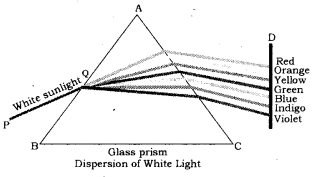(a) What is dispersion of white light. What is the cause of such dispersion. Draw a diagram to show the dispersion of white light by a glass prism.
(b) A glass prism is able to produce the spectrum when light passes through it, but a glass slob doesn’t produce any spectrum. Explain why it is so.
(a) Dispersion: The splitting of white light into its seven component colours is called
dispersion.
Cause of dispersion: Dispersion of white light occurs because of the varying speeds of different coloured lights through different media. White light consists of seven colours. The speeds of these coloured lights are the same through air. However, their speeds vary in other media. Therefore, when white light enters from one media to another, its component colours get refracted by different angles. As a result, dispersion occurs.

Dispersion of white light by a glass prism
(b) The two forces of a glass prism are at an angle (angle of prism) with each other. Therefore, the angle of incidence and the angle of emergency of a light ray become different in the case of a prism. Therefore, when white light gets dispersed after entering a prism, its component colours spread more after refracting through the opposite face of the prism.
In the case of a glass slab, the two opposite faces of the slab are parallel to each other. Therefore, the angle of incidence and the angle light after refracting through the second face of the glass slab.